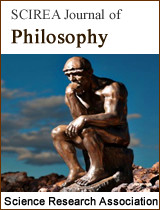Knowledge Mining Based on the Valid Aristotelian Modal Syllogism ⼞AA◇A-1
DOI: 10.54647/philosophy720086 24 Downloads 41753 Views
Author(s)
Abstract
This paper firstly presents knowledge representations of Aristotelian modal syllogisms based on the structure of modal categorical propositions; Then, the validity of syllogism ⼞AA◇A-1 was proved by using the truth value definitions of these propositions. And then this syllogism was used for knowledge reasoning with the help of some reduction operations. More specifically, the validity of the other 30 syllogisms can be inferred from that of ⼞AA◇A-1 with the help of possible world semantics and generalized quantifier theory. Owing to the possible modality (◇) and necessary modality (⼞) can be defined mutually, and any one Aristotelian quantifier can define the other three, so there are reducible relations between/among 31 valid Aristotelian modal syllogisms. Due to the other 30 valid syllogisms obtained by deductive methods, these results are consistent. That is superior to previous works. This formal method is consistent with the ideas of knowledge mining in artificial intelligence.
Keywords
Aristotelian modal syllogisms; reducible relations; knowledge reasoning; knowledge mining
Cite this paper
Qing Cao, Long Wei,
Knowledge Mining Based on the Valid Aristotelian Modal Syllogism ⼞AA◇A-1
, SCIREA Journal of Philosophy.
Volume 4, Issue 1, February 2024 | PP. 1-10.
10.54647/philosophy720086
References
| [ 1 ] | Bo C. (2020). Introduction to Logic (4th Edition), China Renmin University of Press. (in Chinese). |
| [ 2 ] | Chellas, F. (1980). Modal Logic: an Introduction. Cambridge: Cambridge University Press. |
| [ 3 ] | Geach, P. T. (1964). Review of McCall (1963). Ratio, (6), 200-206. |
| [ 4 ] | Ivanov, N., & Vakarelov, D. (2012). A system of relational syllogistic incorporating full Boolean reasoning. Journal of Logic, Language and Information, (21), 433-459. https://doi.org/10.1007/s10849-012-9165-1 |
| [ 5 ] | Johnson, F. (1989). Models for modal syllogisms. Notre Dame Journal of Formal Logic, (30), 271-284. |
| [ 6 ] | Johnson, F. (2004). Aristotle’s modal syllogisms. Handbook of the History of Logic, I, 247-338. https://doi.org/10.1016/S1874-5857(04)80006-2 |
| [ 7 ] | Łukasiewicz, J. (1957). Aristotle’s Syllogistic: From the Standpoint of Modern Formal Logic. Second edition, Oxford: Clerndon Press.9-14. (in Chinese) |
| [ 8 ] | Malink, M. (2006). A Reconstruction of Aristotle’s Modal Syllogistic. History and Philosophy of Logic, (27), 95-141. |
| [ 9 ] | McCall, S. (1963). Studies in Logic and the Foundations of Mathematics. Aristotle’s Modal Syllogisms. North-Holland Publishing Company, Amsterdam. |
| [ 10 ] | Moss, L. S. (2008). Completeness theorems for syllogistic fragments. In F. Hamm, & S. Kepser (Eds.), Logics for Linguistic Structures (pp. 143-173). Mouton de Gruyter, Berlin. |
| [ 11 ] | Cheng Zhang. How to Deduce the Other 91 Valid Aristotelian Modal Syllogisms from the Syllogism ⼞I⼞A⼞I-3, Applied Science and Innovative Research, 2023,7(1): 46-57. |
| [ 12 ] | Peters, S., & Westerståhl, D. (2006). Quantifiers in Language and Logic. Claredon Press, Oxford. |
| [ 13 ] | Thomason, S. K. (1993). Semantic Analysis of the Modal Syllogistic. Journal of Philosophical Logic, (22), 111-128. |
| [ 14 ] | Westerståhl, D. (1989). Aristotelian syllogisms and generalized quantifiers, Studia Logica, XLVII(4), 577-585. https://doi.org/10.1007/BF00370209 |
| [ 15 ] | Zhang, X. J. (2018). Axiomatization of Aristotelian syllogistic logic based on generalized quantifier theory. Applied and Computational Mathematics, 7(3), 167-172. https://doi.org/10.11648/j.acm.20180703.23. |
| [ 16 ] | Zhang, X. J. (2020a). Reducible relations between/among Aristotle’s modal syllogisms. SCIREA Journal of Computer, 5(1), 1-33 |
| [ 17 ] | Zhang, X. J. (2020b). Screening out all valid Aristotelian modal syllogisms. Applied and Computational Mathematics, 8(6), 95-104. https://doi.org/10.11648/j.acm.20190806.12 |

